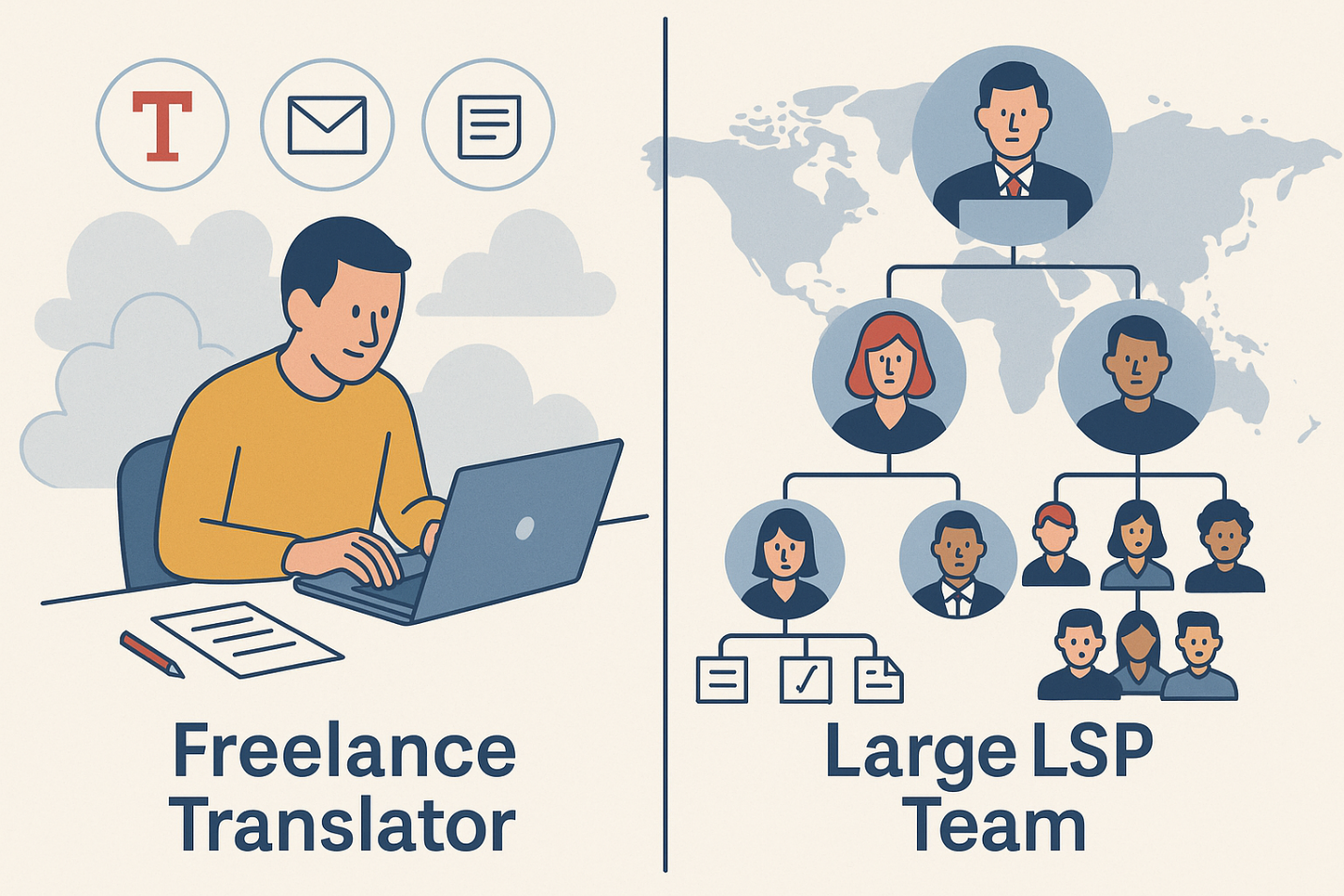
This article is based on the experience of a someone who runs two translation companies that have become leaders in their own countries. In both cases, the translation management system was one of the most crucial factors in their growth.
Spoiler:
If your company has grown even beyond its infancy,
you’re going to want to implement a TMS, and quickly.
Catch-22
When you ask them, “What software do you use to manage your company?” a lot of LSP owners and managers will say: “None,” or, “We keep everything on Excel.” When asked “Why?” they say: “It’s what we’re used to,” “Excel/Google Sheets is all we need,” “We don’t want to trouble ourselves with that,” “We don’t have the time, and that sort of thing is too much.”
The typical features of a company like this are:
— No central database of clients and translators.
— Managers manually assign jobs by email.
— The accountant creates invoices in Word.
— Project files are kept in folders locally on company computers and can only be accessed by the people who work on those computers.
— Every manager has their own working system that only they know about, and if they go on vacation or get sick, the other managers don’t know what’s going on with their projects.
But despite all this, the company management is convinced that for their purposes a translation management system is unnecessary. And the company goes on taking up its employees’ time on all those mechanical tasks that modern software can do in seconds.
In fairness, we should say that smaller companies really can operate without using a TMS. But their future development will always be limited by the manager’s ability to keep everything that’s going on there in their head. As the company grows, so too do the number of things going on there. One fine day, it crosses some critical point and the situation gets out of hand.
Because the volume of day-to-day tasks has gone way up, the manager ends up spending all their time on urgent day-to-day work, and because they spend all their time on day-to-day work, the volume of day-to-day tasks goes on increasing. Metaphorically speaking, the water is rushing into this sinking ship, but instead of trying to stop the leak, all the crew, including the captain, are busy bailing out water.
Without a central management system, the manager cannot get a general overview of what’s going on. The more he puts off installing one, the more money he stands to lose in the future. And the future will inevitably come.
Make a list of the functions you need
Once you’ve got over your own inertia and thought about implementing a translation management system, the first thing to do is make a list of the functions that it will need to perform. For example:
— Keeping data on clients, their contacts, prices, etc.
— Maintaining a user base: which language pairs they work with, what services they offer at what prices, etc.
— Keeping track of projects, jobs being automatically issued to translators directly from the system.
— Creating invoices for clients and users, tracking payments.
— Financial reporting on the company, clients, services, etc.
Your list may well be different, but the important thing is to have one. A TMS must perform specific tasks. If you don’t know what you need, you risk buying a luxury airliner when an ordinary truck would do.
PC or cloud?
First of all you need to determine what type of management system you require:
— A PC-based (“desktop”) application you have to install on your PC.
— A web-based service (“SaaS”) for which you have to set up a user account.
We discussed the pros and cons of these two technologies in a separate article.
Some cloud-based TM systems also have separate applications for different operating systems, and in this way they could be counted as both.
Extensive testing
Don’t settle on a management system right after you get the presentation: First check out the competition, including the one’s that didn’t impress you at first.
Don’t choose a TMS based on the list of functions it supports. The same function listen in several different systems may in reality operate in different ways. In fact, the same name may be used in different systems for completely different functions.
Look at trial versions of the systems. Create test entries, study the menu layout, verify access permissions. Don’t just test the functions, test how easy they are to use, and the responsiveness of the support team. This last point is very important: when you start working with a system you are going to have a lot of questions from the outset, and good quality technical support will save you a huge amount of time.
Don’t look for the perfect system
Your company is unique (that’s not a compliment). You can guarantee there will be some processes you work with that aren’t used by other companies. Ideally, all of these should be taken care of by your translation management system.
But if the developers of the TMS have not built it to your requirements, they are hardly likely to consult you on this: they have figured out a set of average requirements and worked to bring their system in line with these. It is therefore unlikely that any commercially available management systems will match your requirements 100%. From your point of view, every system is going to lack certain functions you need and have certain functions you don’t.
Conclusion: choose the system that suits you above all the others. If it is 80% right for you, you’re left with just 20% of unsolved issues — in other words, you’ll have reduced the number of problems by a factor of four. You’ll need to come up with other ways of solving these — and now you’ll have the time to do that.
There is another alternative, and that is to develop your own project management system. This is such a broad subject that we dedicated a separate article to it.
Make sure the developers are still “alive”
The common peril of start-ups and small companies is sustainability. Soon after a successful start, a lot of them collapse or are absorbed by their larger competitors.
A management system with no one to work on its development and maintenance can be a source of great technical anguish. To avoid this, go onto the developer’s website, study all their social media accounts and check if they have added any notifications on them, especially about releasing new versions of their system. Send questions to their technical support team and check their reaction speed and their readiness to help.
If it becomes clear that the system’s best days are behind it, you’re better off not contacting them. A system is kept alive only for as long as it keeps developing; a system that is not developing will ultimately go the way of the dinosaurs.
Ask for new functions
As we have already said, the developers don’t know which functions are particularly important to you. Let them know what else you need from the system, and find out if they can put that into practice. It is likely that your request will actually set the future course of the system’s development, especially if similar requests have come in from other companies, too.
If the functions you are asking for are unique and you’re the only one that needs them, you can agree a price with the developers to adapt the system to your requirements. It won’t be cheap, but it will be a lot cheaper than developing your own system.
Make sure it’s compatible
Modern web-based systems do not operate in isolation: generally speaking, they can “communicate” with systems from other developers. This means you don’t have to manually transfer data from one system to another.
For example, once you create a project in your project management system, you can automatically create a “symmetrical” translation project on a cloud-based CAT system from a second developer, which in turn incorporates a machine translation service from a third. This possibility means data is able to migrate between different services without you getting involved.
If you are already using any web-based applications, find out if the translation management system you are interested in is compatible with them.
Made your choice? Get it installed!
There is a children’s puzzle that goes like this: three birds were sitting in a tree when two of them decided to fly away. How many birds were left? The answer isn’t what you expect: three! Because deciding is not the same as doing.
Company managers always have things to do that they can’t put off (we dedicated a separate article to this). But you will never get more time: you’ll have just as many urgent things to do tomorrow. “I don’t have time” is not a reason to hold back on installing a TMS, but a consequence of the fact that you haven’t installed one yet.



.png)

